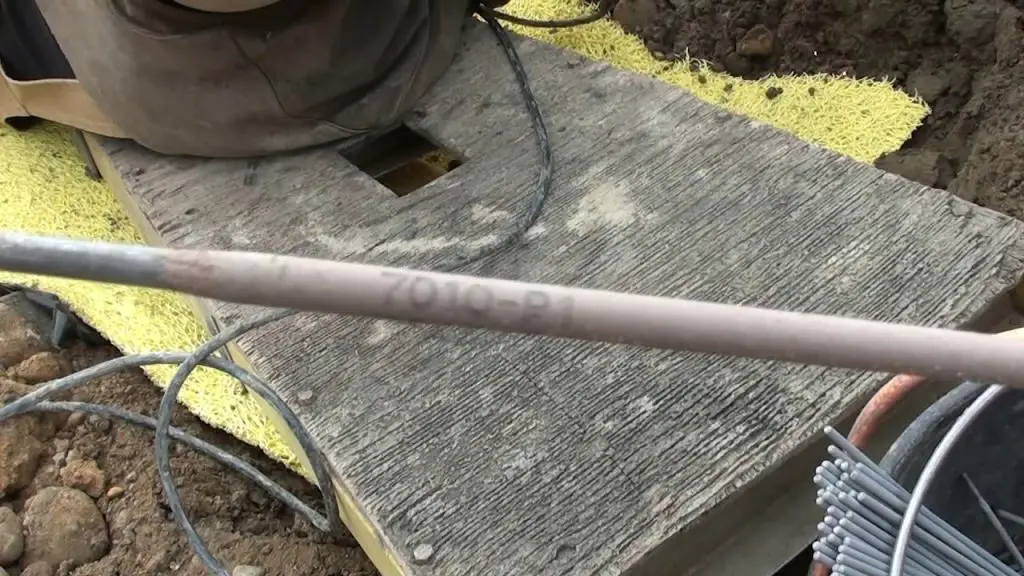When you’re welding, choosing the right equipment is important. Your welding rod or electrode is one of the most important things you have to pick out when you start arc welding. It’s always good to have many different welding rods in your stash. Some welding rods are versatile, multipurpose tools, while others work better for specific materials or purposes.
The 7010 welding rod is one of those electrodes with a very specific purpose. It is used for pipeline welding, so you are not likely to need it for your DIY workshop at home. It works so well for pipeline welding because of its high cellulose coating and easy use for vertical welding.
Here are more details about the 7010 welding rod and its uses.

Table of Contents
What Are the Properties of a 7010 Welding Rod?
Before getting into its uses, it’s useful to learn what a 7010 welding rod actually is.
A 7010 welding rod is an electrode with a high cellulose coating made of rutile, a type of titania oxide, and iron powder.
Certain properties of 7010 welding rods make them ideal for use in high-pressure welding situations that you usually encounter while working professionally. Specifically, 7010 welding rods produce a welding puddle that freezes fast, which makes it easier to work quickly and weld objects together.
The positionality of these welding rods is also an asset in their favor. They can work in all positions but are ideally suited for vertical up and vertical down welds. Many other welding rods do not work well with vertical welds, giving the 7010 a unique advantage in tough welding positions.
Of course, 7010 welding rods come in a variety of thicknesses, which will affect the amperage you use. If you are a professional pipeline welder, you know how important it is to have the right equipment. You should have a few different 7010 welding rods in your toolbox, so you can switch them out depending on the thickness and amperage of the weld you need to do. These electrodes come in a few different thicknesses, including:
- 3/32 inches
- 3/16 inches
- 5/32 inches
- 1/16 inches
- 1/8 inches
Polarity
A 7010 welding rod has a polarity of DC+ (or DCEP) and DC- (or DCEN). Those are the polarity options on most common welding machines anyway. While 7010 welding rods don’t work with AC currents, AC currents are considered outdated in the welding world.
Tensile Strength
The 7010 welding rod’s tensile strength is indicated in the first two digits of the name. The “70” stands for tensile strength in ten thousand psi. So, its tensile strength is 70,000 psi or pounds per square inch. That’s pretty tough for a welding rod, making this electrode ideal for high-pressure situations.
Penetration
The 7010 welding rod has a deep penetration, meaning that it goes well below the surface of the metal when it creates a joint. That means that your weld will be very strong. Welding rods with deep penetration are also better suited for thicker materials.
What Is A 7010 Welding Rod Used For?
Now that you know the characteristics of a 7010 welding rod, you can understand why it’s so popular for heavy-duty industrial applications, especially pipeline welding. You can also use it for equipment and machinery repairs.
Pipeline Welding
Manufacturers developed 7010 welding rods to use just for pipeline welding. The unique properties of this welding rod help solve many of the problems involved in welding pipelines.
Workers weld on pipelines often have to use vertical down welds. However, most welding rods don’t do well in this position, including rods that are supposed to work in every position. The 7010 welding rods work best in vertical positions, especially vertical down welding. That means repairing pipelines is easy.
Plus, the 7010 welding rods penetrate deep into the metal and are fast welds. That makes them ideal for joining thick pieces of pipe while working quickly in high-pressure conditions.
Equipment Repair
Although the 7010 was developed for pipeline welding, that doesn’t mean it can only be used for pipeline welding. You can use this welding rod to repair boilers, oil well casings, shafts, and even farm equipment. Any equipment that has pipe or pipe-like components is fair game for repairs.
In addition, 7010 welding rods are a perfect match for working with molybdenum steel alloys, which are common materials for pipeline welding.
What Types of Welding Are Suited for the 7010 Welding Rod?
There are a few types of welding where the 7010 welding rod works best, including:
- Root welding
- Hot pass welding
- Stove piping
All of these types of welding are important techniques in pipeline welding.
Final Thoughts
Although DIY welders are unlikely to need a 7010 welding rod, this sturdy tool with deep penetration and excellent welds in vertical positioning is an asset for professional pipeline welders.

